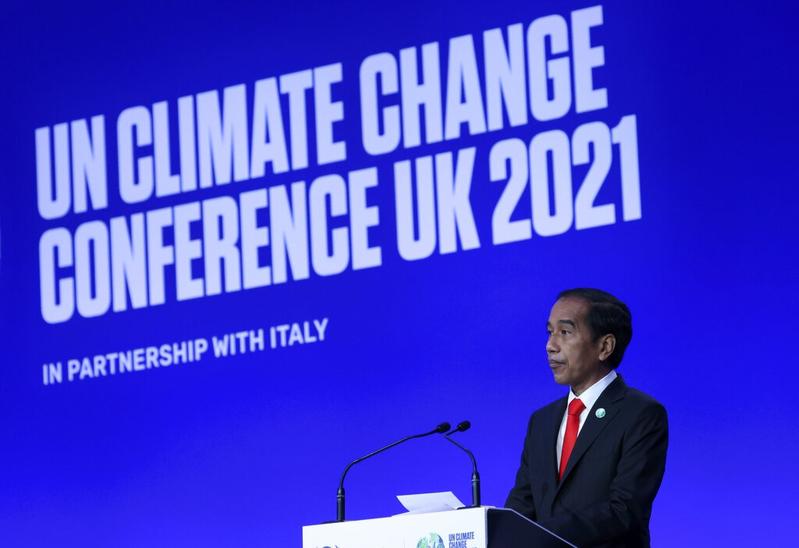 Indonesia's President Joko Widodo speaks during the opening ceremony of the UN Climate Change Conference COP26 in Glasgow, Scotland, Nov 1, 2021. (YVES HERMAN / POOL VIA AP)
Indonesia's President Joko Widodo speaks during the opening ceremony of the UN Climate Change Conference COP26 in Glasgow, Scotland, Nov 1, 2021. (YVES HERMAN / POOL VIA AP)
The future appears bright for Indonesia's solar energy sector as Southeast Asia's biggest economy aims to raise its renewable energy capacity to meet its climate commitments, experts said.
Indonesia has pledged to reduce emissions by 29 percent under a business-as-usual scenario, and by 41 percent, with international support, by 2030. The country is among the world's top emitters due to deforestation and its dependence on coal-fired power plants.
Indonesian President Joko Widodo, who spoke at the COP 26 climate summit in Glasgow this week, said his country plans to increase the use of renewables to reduce emissions.
A 10-year electricity procurement plan that the state-owned utility firm Perusahaan Listrik Negara issued in October revealed that it aims to add 20.9 gigawatts of renewable energy capacity in the next few years. This means renewable energy will account for more than half the additional energy capacity. The company plans to add 4.68 GW of solar power capacity by 2030.
"Indonesia can increase (its climate) ambition because there's so much potential in solar energy," said Fabby Tumiwa, executive director of the Institute for Essential Services Reform, a think tank in Jakarta.
According to a study by the think tank, Finland's Lappeenranta University of Technology and the German think tank Agora Energiewende that was published in May, the reduction in the prices of batteries and solar photovoltaic systems and the huge solar potential throughout the country can make solar energy the primary source of electricity generation in Indonesia by 2050.
The study estimates that solar power can account for as much as 88 percent of total electricity generation.
"Why solar? Because the price (of solar panels and batteries) has been going down rapidly and we have yearlong (source of) solar power," said Elrika Hamdi, an energy finance analyst at the US-based Institute for Energy Economics and Financial Analysis.
Location matters
Indonesia lies along the equator and this location ensures that the whole archipelago can harness sunlight-a free resource-throughout the year.
The 100% Renewable Energy team, or RE100, at the Australian National University in Canberra reported that the potential of Indonesia's solar energy sector is even greater than that of other countries that are now home to large solar energy installations.
Indonesia's Ministry of Energy and Mineral Resources estimates that the country has the potential to produce nearly 208 GW of solar energy, yet solar generation in the country is less than 1 percent now, according to the Institute for Essential Services Reform.
David Silalahi, a member of the RE100 team, believes solar and other renewable energy sources can replace coal as Indonesia's main energy resource ultimately. And it can start by gradually retiring each of the country's over 200 coal-fired power plants.
The utility firm Perusahaan Listrik Negara said it will stop building coal-fired power plants after 2023 and phase out coal for electricity by 2056, enabling Indonesia to reach net-zero carbon emissions by 2060.
At COP 26, the Asian Development Bank launched the Energy Transition Mechanism, or ETM, that will accelerate Indonesia's and the Philippines' transitions to clean energy.
Paul Butarbutar, executive director of the Indonesia Renewable Energy Society, welcomes the ETM and how it will help in financing the renewable energy sector.
Another constraint is the Indonesian government's rule that more than 40 percent of a solar photovoltaic project must be composed of locally made equipment. Butarbutar said local production of components, like solar modules and batteries, remains limited and these are more expensive than imported items.


